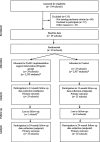Scale-up of the Physical Activity 4 Everyone (PA4E1) intervention in secondary schools: 24-month implementation and cost outcomes from a cluster randomised controlled trial
- PMID: 34688281
- PMCID: PMC8542325
- DOI: 10.1186/s12966-021-01206-8
Scale-up of the Physical Activity 4 Everyone (PA4E1) intervention in secondary schools: 24-month implementation and cost outcomes from a cluster randomised controlled trial
Abstract
Background: Physical Activity 4 Everyone (PA4E1) is an evidence-based program effective at increasing adolescent physical activity (PA) and improving weight status. This study aimed to determine a) the effectiveness of an adapted implementation intervention to scale-up PA4E1 at 24-month follow-up, b) fidelity and reach, and c) the cost and cost-effectiveness of the implementation support intervention.
Methods: A cluster randomised controlled trial using a type III hybrid implementation-effectiveness design in 49 lower socio-economic secondary schools, randomised to a program (n = 24) or control group (n = 25). An adapted implementation intervention consisting of seven strategies was developed to support schools to implement PA4E1 over 24-months. The primary outcome was the proportion of schools implementing at least four of the 7 PA practices, assessed via computer assisted telephone interviews (CATI) with Head Physical Education Teachers. Secondary outcomes included the mean number of PA practices implemented, fidelity and reach, cost and cost-effectiveness. Logistic regression models assessed program effects.
Results: At baseline, no schools implemented four of the 7 PA practices. At 24-months, significantly more schools in the program group (16/23, 69.6%) implemented at least four of the 7 PA practices than the control group (0/25, 0%) (p < 0.001). At 24-months, program schools were implementing an average of 3.6 more practices than control schools (4.1 (1.7) vs. 0.5 (0.8), respectively) (P < 0.001). Fidelity and reach of the implementation intervention were high (> 75%). The total cost of the program was $415,112 AUD (2018) ($17,296 per school; $117.30 per student).
Conclusions: The adapted implementation intervention provides policy makers and researchers with an effective and potentially cost-effective model for scaling-up the delivery of PA4E1 in secondary schools. Further assessment of sustainability is warranted.
Trial registration: Australian New Zealand Clinical Trials Registry ACTRN12617000681358 prospectively registered 12th May 2017.
Keywords: Adolescents; Cost-effectiveness; Fidelity; Implementation; Multi-component; Physical activity; Randomised controlled trial; Reach; Scale-up; School.
© 2021. The Author(s).
Conflict of interest statement
Authors RS, LC, NN, LW, KG, MW, NE, AB and JW receive salary support from their respective Local Health Districts. Hunter New England Local Health District contributes funding to the PA4E1 program.. All other authors declare that they have no competing interests.
Figures



References
-
- Australian Institute of Health and Welfare . Impact of physical inactivity as a risk factor for chronic conditions: Australian burden of disease study. Australian burden of disease study series no. 15 cat. No. BOD 16. Canberra: AIHW; 2017.
-
- Milton K, Cavill N, Chalkley A, Foster C, Gomersall S, Hagstromer M, et al. Eight investments that work for physical activity. J Phys Act Health. 2021;18(6)625–30. 10.1123/jpah.2021-0112. - PubMed
Publication types
MeSH terms
LinkOut - more resources
Full Text Sources
Medical

